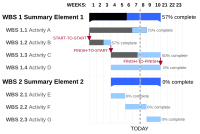
Photo from wikipedia
This paper extends the scheduling methodology for complex stochastic networks that is based on the solution of a “fluid” relaxation (FR) at each decision point of the original scheduling problem… Click to show full abstract
This paper extends the scheduling methodology for complex stochastic networks that is based on the solution of a “fluid” relaxation (FR) at each decision point of the original scheduling problem to stochastic networks with blocking and deadlocking effects. For a clearer and more concrete treatment, the presented results are developed in the operational context of a re-entrant line (RL) with finite buffering capacity at each workstation; these RLs are characterized as “capacitated RLs (CRLs).” From a methodological standpoint, the paper results are enabled by a pre-established ability to control the underlying resource allocation for deadlock freedom and by the further ability to express the corresponding deadlock avoidance policy as a set of linear inequalities on the system state. Also, the employed FR for this new regime differs from the FRs that have been employed in past implementations of the method since it must account for the blocking effects that take place in the considered CRLs. The efficacy of the presented scheduling method is assessed through numerical experimentation that compares, for a set of “benchmark” CRLs, the performance of the scheduling policies obtained through this method to 1) the performance of the corresponding optimal scheduling policies and also to 2) the performance of some other heuristic scheduling policies for these systems that are adapted from the relevant literature. Finally, an additional set of experiments demonstrates and assesses the scalability of the presented method by applying it to some pretty large system configurations. Note to Practitioners—While the real-time management/scheduling of complex resource allocation systems (RASs) is a thriving area in general, the particular problem of scheduling such systems with extensive blocking and deadlocking effects in their operation has received very limited attention. To a large extent, this is due to the fact that the effective scheduling of this particular RAS class requires the initial resolution of an additional problem, of a more combinatorial type, that concerns the establishment of “liveness” for the underlying workflow, i.e., the ability of all the activated jobs to proceed to their completion securing successfully all the required resources for the execution of their various processing stages, and avoiding the formation of any deadlocks or livelocks. On the other hand, this problem of liveness enforcement for the considered RAS has received extensive attention within a certain part of the controls community during the past decades, and the currently available results provide a broad range of methods and policies for supporting the necessary supervision. This paper combines the aforementioned results on the RAS liveness-enforcing supervision with a scheduling methodology that has been very popular in the context of other hard scheduling problems in order to develop a complete scheduling methodology for the considered RAS. Extensive numerical experimentation reported in this paper demonstrates and assesses the efficacy of the presented method. Finally, in an effort to provide more concrete and simpler exposition for the presented developments, the results are presented in the operational context of a “capacitated re-entrant line (CRL),” i.e., a particular RAS class modeling the operation of RLs with finite buffering capacity at its various workstations.
Journal Title: IEEE Transactions on Automation Science and Engineering
Year Published: 2019
Link to full text (if available)
Share on Social Media: Sign Up to like & get
recommendations!